The Next AI Bonanza:
100x Bigger Than ChatGPT
Here’s how to grab the opportunity today …

I’m Martin Weiss, founder of Weiss Ratings with an urgent report on how artificial intelligence is about to cause a multitrillion-dollar disruption in one of the most important industries known to man.
Already, our stock ratings have helped deliver major profits for investors in the field of AI.
Take Nvidia, for example, the biggest AI chipmaker.
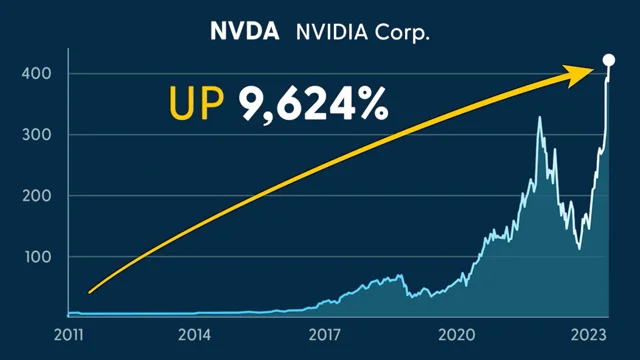
In 2023, after Wall Street finally discovered it, Nvidia shares rose 191%, truly a big win.
But our Weiss stock ratings had already identified Nvidia as a “Buy” back in 2011, and investors who bought it then could have seen gains of 9,624%.
That’s over 50 times more than investors
who just discovered Nvidia this year.
Plus, Nvidia is not the only big gain investors could have seen with our “Buy”-rated AI stocks.
Investors who recently bought another AI stock based on our “Buy” rating could have enjoyed gains of 810%.
That was ASML.
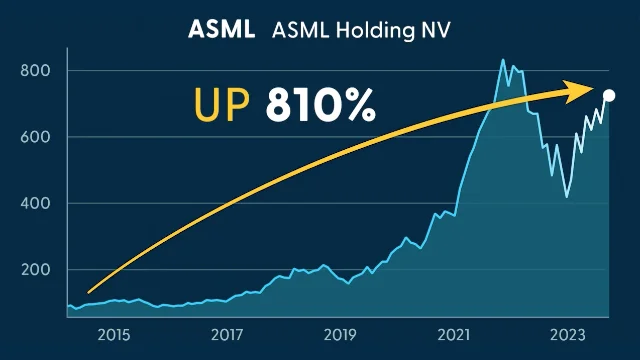
On Lam Research, they could have done even better: Gains of 3,146%.
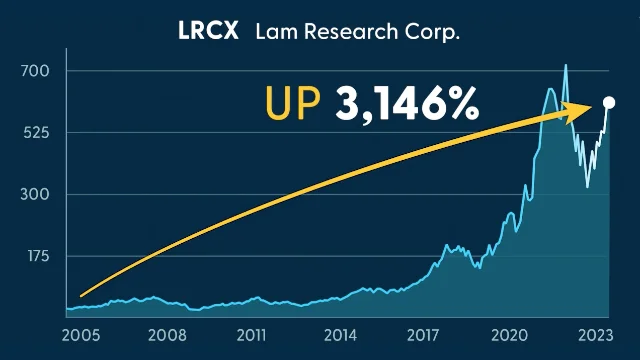
And if you’d bought Ansys when we first recommended it, you’d be up 5,466%.

I’m proud to say we were there first.
And I’m equally proud to say that, today, we’re moving on to the next phase of the AI revolution which, based on our data, could be 100 times bigger.
I’ll tell you about our top picks in just a moment.
But first, let’s take a quick look at how we got this far long before Wall Street. Apps like ChatGPT use a technology called generative AI, which learns from itself.
With a series of simple prompts from users like me, it can write a fully developed novel, a research paper or a company memo.
I think ChatGPT is quite amazing, and I’m not alone.
ChatGPT reached 100 million users more quickly than any app in history, a proven fact that shows how this new AI revolution is much bigger — and much faster — than any other tech revolution. Ever!
For mobile phones to reach 100 million users, it took 16 years.
For the World Wide Web to reach 100 million users, it took seven years.
Facebook took four and a half years.
And Instagram did it in two and a half years.
But ChatGPT? Hah!
ChatGPT busted through the 100-million-user
mark in just two short months.
That’s …
- 15 times faster than Instagram …
- 27 times faster than Facebook, and …
- 96 times faster than smartphones.
Clearly, AI adoption is moving at breakneck speeds compared to all previous tech disruptions.
So, it stands to reason that the returns investors could reap in market-leading AI stocks should also come much faster than in previous tech disruptions.
And here’s the truly big news: What you’ve seen so far with generative AI like ChatGPT is just the opening salvo, just the first baby steps in the AI revolution.
Right now, AI is hitting an inflection point for both AI scientists and investors like us.
It’s the time when AI is opening the floodgate for a far bigger opportunity than anyone thought possible.
The big challenge for AI scientists is to address how companies can successfully use AI.
And the big opportunity for investors is to identify which major industry, and which leading companies in that industry, will be the first to do it.
The first companies to use AI to massively upgrade their products …
The first to use AI to double and triple their profitability …
And the first to use AI to make life-changing improvements for society.
We’ve identified that industry and I will tell you what it is in less than one minute.
You see, Bloomberg says the current AI breakthroughs — things like ChatGPT — will help investors make billions of dollars.
Good.
But the kind of AI that we’re going to dive into today is going to do much better than that.
It’s going to SAVE billions of LIVES.
And when people do good for mankind, they naturally do well for themselves as well.
In fact, a recent article in Forbes says the new AI breakthroughs I’m going to tell you about now will not only save billions of lives …
They will also create the world’s first trillionaires.
I’m talking about healthcare, including pharmaceuticals, biotech and life sciences.
According to a just-released study by Goldman Sachs, healthcare is especially ripe for disruption by artificial intelligence.
In fact, it was the first large industry to use artificial intelligence in a major way.
For years and years, it has used AI-based diagnostics in radiology, in pathology and in patient monitoring.
Consider the PAPNET Testing System, for example. It was the very first AI-based system approved by the FDA, and guess when! Back in 1995, when almost no one even knew what AI was.
Then in the early 2000s, the FDA approved AI-based systems for digital images, for analysis of cells, for bedside monitoring of vital signs and for warning systems that could automatically alert hospital staff when medical intervention is needed.
Healthcare was the first major sector in the world to use AI for one simple reason: It already had Big Data that AI needs.
It already had the precision instruments that could be programmed with AI.
It always had the urgent need: To help save lives! And fortunately, healthcare stocks are also where our Weiss stock ratings have beaten every other analyst and every other algorithm we know of.
Since we first issued “Buy” ratings on the nation’s most promising healthcare companies, investors could have used them to build very substantial wealth.
By following our ratings, they could have seen …
- 1,073% gains in U.S. Physical Therapy …
- 1,086% gains in Elevance Health …
- 1,154% gains in Waters Corporation …
- 1,307% gains in Eli Lilly …
- 1,499% gains in CorVel …
- 1,656% gains in Bio-Techne …
- 1,666% gains in AmerisourceBergen …
- 1,730% gains in Chemed …
- 1,874% gains in Danaher …
- 2,357% gains in UnitedHealth Group …
It goes on — there’s more:
- 2,513% gains in ResMed …
- 2,952% gains in Thermo Fisher Scientific …
- 3,147% gains in Atrion Corporation …
- 4,070% gains in ICON Public Limited Company …
- 4,234% gains in Mettler Toledo and it continues ...
- 5,127% gains in Humana …
- 5,683% gains in IDEXX Laboratories …
- 6,256% gains in Intuitive Surgical, and that’s a special stock I’ll tell you a little bit more about in a moment.
- 8,882% gains, in West Pharmaceutical Services. And here’s the biggest of all …
- 9,805% gains in Simulations Plus.
In a moment, I’ll tell you about our picks for the best AI healthcare investments for 2023.
But for now, let me say this: Even the worst performer on our early “Buy” list — Pfizer — is up 179%, or nearly triple your money.
In total, in the first three years of our Weiss stock ratings, we gave “Buy” ratings to 34 healthcare companies, which we’ve never since downgraded to a “Sell.”
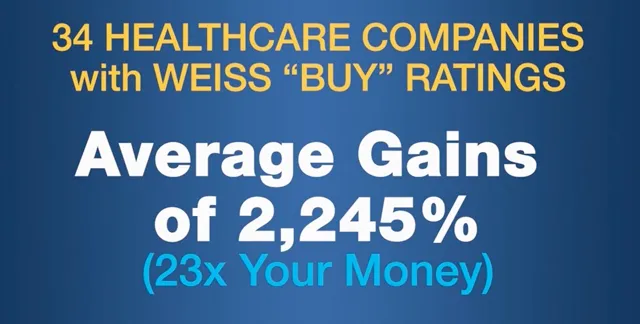
On these 34 stocks we picked, investors could have seen average gains of 2,245%, or more than 23 times their money.
With no losers.
Of course, losses are always possible, but in this particular set of 34 companies, there were none.
Moreover, these results are not taken from some hypothetical, “back-tested” model. We’ve been using it, refining it and perfecting it in real time for over 20 years.
It has stood the test of time, and it works.
It works because it’s not based on hearsay or some particular investment “philosophy.” It’s based on the data and nothing but the data.
And it works because, unlike the top Wall Street firms and ratings agencies …
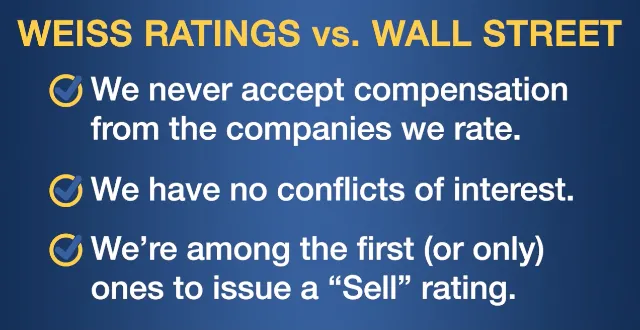
We never have accepted — and we never will accept — a dime of direct or indirect compensation from any company we rate.
We have no conflicts of interest at all. And this is why, unlike Wall Street, which gives out “Buy” ratings like candy, we’re tough.
As soon as any company fails our tough tests, we’re usually the first — and sometimes the only — rating agency to issue a “Sell” rating.
This independence, combined with our track record of success, is why I say investors can trust our top picks for the AI revolution that’s now sweeping through the healthcare industry.
It’s also helps explain why …
The Wall Street Journal reported that our Weiss Stock Ratings ranked #1 for profit performance.
In fact, The Wall Street Journal showed that investors who followed our ratings could have made more money than investors who followed Goldman Sachs, JPMorgan, Merrill Lynch, Standard & Poor’s and all of the 27 major Wall Street firms reviewed.
Today, I’ll tell you about the best of the best of our “Buy” list right now.
But first, I want to explain exactly why a focus on Healthcare is so important.
Healthcare is where AI is now beginning to change people’s lives in a truly fundamental way.
It’s where select companies are already making major advances.
And it’s where I’m convinced investors have the best AI opportunity of all.
Think about it for a moment. How much money have you spent on AI lately? Maybe a few bucks on ChatGPT, right? Or maybe nothing at all.
Heck, even if you spent hundreds of dollars on AI, it’s chump change compared to the thousands — tens of thousands of dollars that are spent on medicines, surgeries and preventative care for just one person every year.
In fact, for the average retired American today, the lifetime cost for healthcare is $1,016,891.
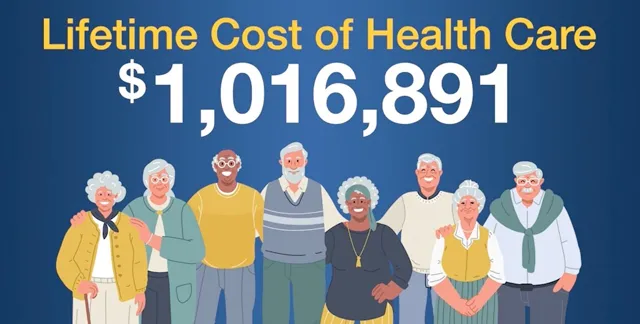
That’s right. Over $1 million dollars.
This helps explain why the revenues in the healthcare industry are about 100 times larger than all the revenues we’ve seen in generative AI so far.
But based on our research, healthcare is not just a larger opportunity. It’s also a safer opportunity.
No one really knows how generative AI apps will change our lives. It’s all very new and it remains to be seen.
But AI-based healthcare? That’s a different story entirely.
We know that …
Healthcare was the first major industry
to widely and successfully use AI, starting in 1995.
Going back much further in time, we know healthcare has been a fundamental aspect of human existence for thousands of years.
We know that living as long as possible is deeply rooted in our instinct for survival.
And we know that healthcare, which is all about life itself, trumps nearly every other human endeavor.
For me and for most of us, healthcare is not a choice. It’s a must.
It takes priority over virtually everything else.
Not just our own healthcare, but the healthcare of our children, our parents, our life partners, our loved ones … and even those we don’t love so much.
We also know another thing. Modern medicine, even in the most advanced countries of the world, is not yet where it needs to be. Not by a long shot.
It cannot cure so-called “incurable” diseases.
It can cause serious side effects.
It’s not yet customized to each individual’s unique genome or DNA.
And for billions of people around the world, even many people living in advanced countries like the United States, the best medical care is simply not available.
This is extremely unfortunate, but it also opens up tremendous opportunities for improvement, thanks especially to AI.
And for investors, wow! This is bigger than big.
So, sure, it was great to ride the first phase of the AI boom, investing in companies like …
- Lam Research, up 3,146% since we told investors to buy …
- Ansys, up 5,466% since we told investors to buy …
- And Nvidia up 9,624% since we told investors to buy.
But we predict that investing in AI healthcare companies is bigger, more sustainable and … safer.
Here’s the challenge: If you waste precious time sitting on the sidelines because you’re not sure how to whittle down your choices, you could be too late …
Which is why I think you should pay especially close attention to what I’m going to say next …
Let’s look at precisely how AI is such a great fit for healthcare. And let’s start with new drugs.
To get approval for a new drug can take up to 15 years or more.
And to bring a new approved drug to market costs a whopping $2.6 billion. On average! So, let’s say you’re talking to a doctor about your healthcare or about the healthcare of a loved one.
And let’s say he tells you about a “brand new drug.” Like Leqembi — the new, but still iffy Alzheimer’s drug that the FDA just approved, for example.
Well, guess when the research and development first started for a new drug that’s introduced today.
If it’s like the average so-called “new” drug, it started way back in the year 2007.
That’s the year the iPhone was first launched.
If you’re an investor, that’s far too long to wait. If you’re a patient, it could be fatally long.
Why is the process so slow? Well, for one thing, when a pharmaceutical company applies for drug approval, it often has to to submit a document that’s at least 100,000 pages long.
One hundred thousand pages! Meanwhile … More than ten million people die from cancer every year.
About 55 million people are living with Alzheimer’s or other forms of dementia.
And 300 million people are living with supposedly incurable “rare” diseases.
These long wait times and huge costs are a tremendous obstacle for the healthcare of millions of Americans every day. Not to mention an obstacle to the explosive growth that’s possible in the healthcare industry as a whole. It’s even worse overseas.
According to The World Health Organization, at least half of the world’s population does not have access to decent healthcare.
That’s 4 billion people.
They may get some care, but it’s spotty at best. And it’s a far cry from getting the best healthcare on the planet.
Why? Well, one of the biggest reasons is the $2.6 billion it costs, and the 15 years or more that it takes to develop a single drug.
And another big reason is the shortage of doctors. On average, it takes seven years of rigorous, grueling — and expensive training before anyone can even start practicing medicine.
Very few can afford to spend the time and money it takes to become a practicing physician, and only a tiny fraction of those people isis willing to work in areas that pay below average fees.
But now consider this big news:
An AI computer program just passed the U.S. medical exam,
one of the toughest in the world.
That’s vivid proof that AI-assisted medicine could go a long way toward solving this problem.
In fact, only AI-assisted medicine has a real chance of greatly improving the quality of life for the 4 billion people who currently do not have access to decent healthcare.
This is not a far-fetched future scenario. Thanks to AI, it’s all very possible a lot sooner than anyone previously believed.
And like I said, the healthcare industry has a big head start.
Because the AI revolution in healthcare began well before the whole world was buzzing about things like ChatGPT.
For example, one AI-assisted project developed a new drug candidate for liver cancer. After testing a myriad of protein structures, it found a new way to treat cancer that had never been researched before.
And get this: They did it all in just 30 days! Of course, there’s still more work to be done before this new drug is ready for market.
But it shows that, with AI, the first few years of research could be shortened to as little as 30 days.
Medical research on proteins is another great example. It takes practically forever for scientists to test protein structures one by one.
But with AI, the time — and cost — is cut dramatically.
In fact, one company says that …
AI can reduce the time it takes to
validate a drug by a factor of 100-to-1.
Or consider the rare brain tumor that affects children. It was supposedly “incurable.” And despite all the medical advances over the past half century, the survival rate of children with this brain tumor has not improved.
What’s more, since the disease is so rare, drug companies can’t afford to invest much money in the vast research needed to come up with a cure.
But if you think rare diseases affectdiseases affect only a few people, think again. There are many, many rare diseases. And like I said at least 300 million people are suffering from rare diseases right now.
For those 300 million people, AI is the only bright light at the end of a dark tunnel. A tunnel that would otherwise be very long indeed.
And here’s the proof of concept …
Just recently, AI did find a cure for a supposedly incurable rare disease. I’m talking about DIPG (Fuji’s Disease). What’s the cure? It’s very simple, actually.
It’s the combination of two drugs that have already been approved — two drugs that are already being used daily all over the world.
And as you might imagine, using already-approved drugs is one of the fastest fast tracks to a cure.
This shows that AI can rapidly and efficiently discover new treatment combinations that would probably not be discovered by human researchers for decades. If ever!
So, there you go.
Thanks to AI, medical research has just taken a giant step forward on a disease cure that had gone virtually nowhere for half a century.
Remember, on average, it can take 15 years or more and cost $2.6 billion to bring a single drug to market.
And like I said, it has always been very difficult for healthcare companies to justify spending that kind of money and that kind of time on a rare disease like DIPG.
But now, with AI, many of these rare diseases could have a good chance of being cured.
Is drug discovery the only way AI can transform the science and practice of medicine? Not at all.
CT scans, for instance. CT scans are not exactly easy to read with the naked eye.
Detecting minute foreign objects.
Detecting meaningful patterns.
It takes a lot of training, experience and a sharp, perceptive mind.
AI has the power to do this a lot faster and more efficiently.
Not just with CT scans. AI is also a lot faster and more efficient in detecting disease-causing substances or other signs of disease in the blood.
One more important thing.
I mentioned earlier that training doctors takes a long time and costs a lot of money. Remember? That’s why there’s such a dire shortage of doctors. It’s also why, in many countries, the wait time to see the appropriate doctor is off the charts.
If you live in Poland, for example and you need cataract surgery, the average wait time is 250 days or more.
If you want a hip replacement in Estonia — an advanced country ... but still, you’ll probably have to wait about 280 days.
And if you need a knee replacement, I sure hope you’re not living in Chile. Because there you’d have to wait 839 days. That’s more than two full years.
In the U.S., the wait times are usually shorter. But the cost is many, many times higher.
Why? The main reason is because it takes so long and costs so much money to train surgeons and other specialists.
To be clear, this isn’t just an overseas problem.
According to the American Association of Medical Colleges …
The U.S. faces a projected shortage of
up to 124,000 physicians by 2034.
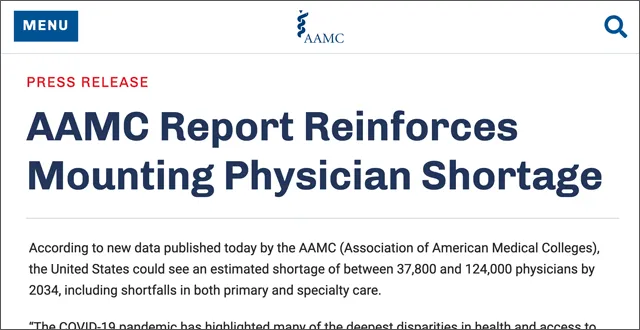
And that’s just due to the aging population.
If you factor in things like inflation or a weaker economy, it could be a whole lot worse.
But remember: For the first time in history, an AI program just passed the U.S. medical exam.
Just one more reason to believe that AI will greatly help alleviate the shortage of doctors, especially when it comes to diagnostics.
Compared to any other aspect of medical practice, AI for diagnostics is what’s expected to alleviate the shortage of doctors the most.
For the initial diagnosis, you may not even need a doctor to begin with. In fact, most of that process could be done with a smartphone.
A smartphone app from the comfort of your home.
This is why Forbes says AI may be the only way to provide better healthcare access to low-income people in the world.
Not 60 million people who lack decent healthcare. Not 600 million people who lack decent healthcare.
But six billion people lacklack decent healthcare.
Training doctors costs hundreds of thousands of dollars. It’s just not feasible, even in our wildest dreams, to expect them to reach every corner of the developing world.
They can’t even reach every corner of wealthier communities in America, for crying out loud.
But just imagine the benefit this can deliver to the 6.9 billion people in the world who own a smartphone.
We’re talking about the potential to give 86% of the world’s population access to life-changing healthcare when AI is used to diagnose patients in their own home with a smartphone app.
Imagine how a doctor’s valuable time could be used so much more efficiently to focus strictly on the things that AI cannot do ... yet.
Result:
AI diagnostics is now projected to grow at an annual rate of 39.9%.
Almost 40% a year.
That means it will double in just two years or more, an extraordinary pace of growth.
Faster than the AI growth rate overall.
And 5.6 times faster than the growth of semiconductors.
Indeed, you’d be hard-pressed to find any major segment in any industry that’s expected to grow that fast.
And here’s the third area of great promise for AI in the healthcare industry: Surgical procedures.
It doesn’t take a stretch of the imagination to foresee what AI could do indo in the operating room.
That’s right. AI robots performing surgical procedures.
An impossible dream?
Not at all. Robots have already reached a level where they can perform complex surgical procedures without direct human assistance.
And this is not based on new experiments conducted since the AI boom that was spurred by the launch of ChatGPT. No.
This is based on an experiment that was done a year and a half before anyone had even whispered the word “ChatGPT.” At that time, for the first time in history, an performed a complex surgery without the assistance of a doctor.
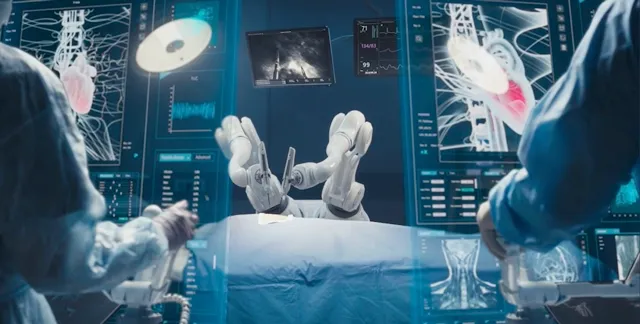
And looking ahead, we can clearly see how AI robotic surgery will enable precision procedures that go beyond the limitations of a surgeon’s hands or a surgeon’s eyes.
It will cut the risk of complications. It will reduce the pain, it will cut down the operating time and the recovery time.
And it will help expand basic surgeries to areas where surgeons are in short supply.
Needless to say, fully autonomous AI robotic surgery is still in its infancy.
But the use of robots in surgery did not begin yesterday. Robots have been used in surgery for more than a decade.
Case in point: The surgical robot “da Vinci.”
It was launched more than 10 years ago and it has performed more than 10 million surgeries in 67 countries.
And now, “da Vinci” will utilize AI to greatly improve its services.
This is where Weiss Ratings has stepped in. Not just now, but long before nearly all other analysts.
And this is where we’ve brought together a dedicated team of experts to give you the opportunity to build real wealth from AI healthcare.
The leader of the team is Jon Markman, our Weiss Ratings analyst.
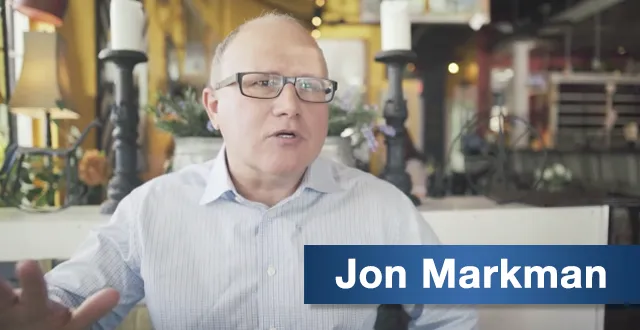
For two decades, Jon has been in the forefront of technology and investments.
For the past 10 years, not only has Jon worked extensively with our data scientists and analysts to improve the formulas behind our Weiss stock ratings …
He’s also a Microsoft veteran from the days Bill Gates ran the company.
That’s when Jon worked personally and directly with their software geniuses to create a computerized, algorithm-based stock picker, called StockScouter.
StockScouter became the heart of Microsoft’s money website, MSN Money, where Jon was the managing editor.
But that was just the prelude to Jon’s illustrious career at Weiss Ratings.
Soon after he joined us 10 years ago, Jon became one of the first tech analysts in the world to predict four major tech megatrends: mobile computing, big data, autonomous vehicles, new medical technologies and, yes, artificial intelligence.
And today all four of those megatrends have become massive profit engines for investors.
In 2019, three years before AI burst onto the scene with ChatGPT, Jon clearly predicted this new phase of the AI boom.
It was at the Money Show in Las Vegas. Thousands of investors attended.
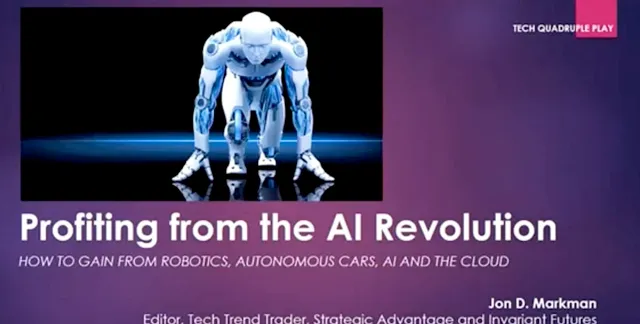
And Jon’s PowerPoint presentation, “Profiting from the AI Revolution”, not only predicted what’s happening now, but but it also pinpointed some of the biggest winners.
All thanks to his long years of experience and our stock ratings.
Jon has worked closely with our data scientists and analysts who develop and perfect our ratings for AI stocks and for healthcare stocks.
I’ve told you about some of the successes we’ve had with both sectors.
From 810% gains on ASML …
To 9,624% gains on Nvidia.
Those were the AI stocks.
And I’ve also told you about some of our successes with Healthcare stocks:
From 1,073% gains on U.S. Physical Therapy, to … 9,805% gains on Simulations Plus.
And as I said, there were zero losers among them. These were long-term, buy-and-hold opportunities.
Meanwhile, there were also many trading opportunities. In fact, based on the Weiss “Buy” and “Sell” ratings from 2009 through 2023, there were 831 possible trades just in the healthcare sector.
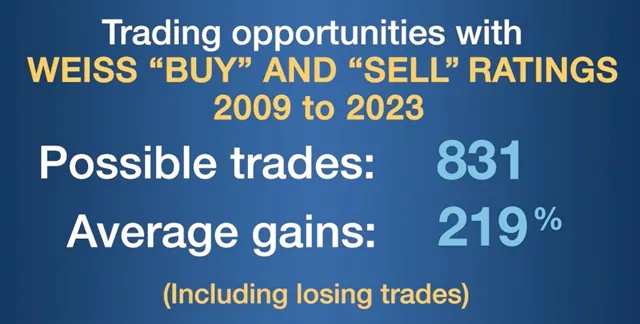
And the average gain among them was 219%, including the losers.
No matter what, losing trades isis always possible and must always be expected. But this isthis is more than triplingtripling your money, on average.
Per trade. Without compounding.
So, you’ve seen the profit power of our ratings with AI stocks in which the explosive boom has already begun.
And you’ve also seen the profit power of our ratings with healthcare stocks where we predict the AI boom is now getting ready to explode in a big way.
So, imagine the potential opportunity in companies that combine healthcare with AI and that are among the first to apply AI to drug discovery, diagnostics, to surgery.
I can’t even put a number on it.
Because I think it could be off the charts. What I can say with confidence is that Jon and his team have been so successful that to my knowledge, our stock ratings — combined with Jon’s experience in healthcare and AI — is absolutely unmatched by anyone, anywhere.
And now, Jon Markman has just prepared three urgent reports to give investors everything they need to jump into this AI-driven healthcare boom.
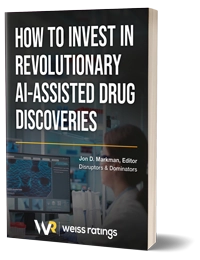
Jon’s first report is How to Profit from Revolutionary, AI-Assisted Drug Discoveries.
Drug discoveries are already a huge market. To give you an idea of how big, consider the company AbbVie.
This one pharma company alone has seen annual sales of more than $30 billion from just one drug, Humira.
By way of comparison, Nvidia’s total sales on all of its products last year were about $27 billion.
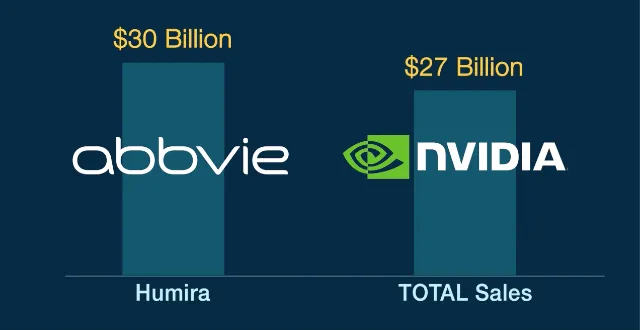
So, AbbVie’s sales for just one product alone ... $30 billion?! That’s right.
In the pharmaceutical industry, we see companies exceeding the entire sales of some big tech companies with just one single drug.
And remember: Overall, the healthcare industry is about 100 times bigger than the generative AI sector.
In his new report, How to Invest in Revolutionary AI-Assisted Drug Discoveries, Jon Markman not only maps out the future potential of using AI to discover new pharmaceuticals …
He also names the one company that can give investors the greatest, and safest, potential gains in this field.
This is the area that’s expected to grow at an annual rate of 39.9% over the next few years.
That’s a much higher growth rate than we’ve seen in the AI market as a whole.
Now, Jon’s second special report is How to Ride the Boom in AI-Based Diagnostics.
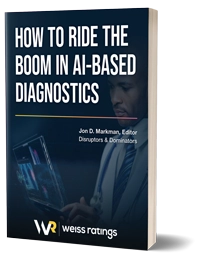
I told you how AI will be able to detect subtle signs and image configurations in CT scans that doctors would otherwise miss.
I told you how it will be able to sift through blood samples with amazing speed and efficiency to find things that specialists could not find despite many years of training.
And I told you how AI-based personal apps will help millions of people diagnose or at least get a good head start on the diagnostic process for common or even uncommon diseases.
All from the comfort of their own home.
Jon shows you why he predicts that each of these AI technologies is about to spark separate booms in the companies that make or service them.
And Jon’s just-released report, How to Ride the Boom in AI-Based Diagnostics shows you precisely what to invest in now for each one.
His third special report is How to Ride the Explosion in AI Surgical Technology.

We talked about the surgical robot “da Vinci” which was launched more than 10 years ago and has performed more than 10 million surgeries in 67 countries.
Well, the name of the company that’s behind da Vinci is Intuitive Surgical.
So, it’s no coincidence it was on our “Buy” list right from the beginning.
And it’s up 6,256% since then.
Nor should you be surprised to hear that Jon has been recommending it for a long time.
At that same Money Show in Los Angeles, when Jon told thousands of investors about the coming revolution in AI, he also highlighted Intuitive Surgical.
Jon told them that Intuitive Surgical was a “tech quadruple play” and “a first mover in cutting-edge surgical tools.”
And now Jon says:
“If you think the 6,256% gains we’ve seen since our ‘Buy’ rating of Intuitive Surgical was a stroke of luck, wait till you see how much the shares of these kinds of companies could surge when they do just one thing: when they marry tried-and-tested surgical hardware with the newest AI software.”
In his report, Jon identifies the best of the best.
Plus, he explains how savvy investors can get in on this kind of opportunity before anyone else.
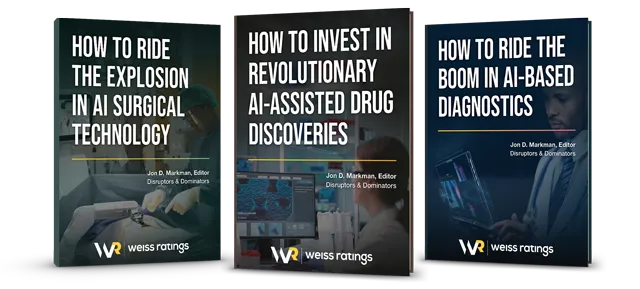
In each and every one of his three urgent reports …
1. How to Invest in Revolutionary AI-Assisted Drug Discoveries …
2. How to Ride the Boom in AI-Based Diagnostics …
3. How to Ride the Explosion in AI Surgical Technology …
Jon not only maps out the opportunity for average investors …
He specifically names the investments to buy right now, down to all the critical details: Their ticker symbols, their prospects for the future, how much pay, how much to expect in returns and much, much more.
But AI is so new … and these amazing applications of AI are evolving so rapidly … there’s not much time to jump in.
Right now, the stocks on Jon’s “urgent buy” list are relatively cheap.
But Jon predicts that, as more investors get wind of the massive changes sweeping through the healthcare sector, these stocks could surge to such astronomical valuations …
He will have to remove them from his “urgent buy” list and one after another, he will need to take these three special reports out of circulation.
Usually, Jon says, that doesn’t happen with his favorite stocks for months or even years.
But the AI revolution is moving so fast — 100 million users for a brand-new AI app in just two months …
That these AI medical tech companies could come off his “buy” list a lot sooner.
This is why he has hurried to release the reports right now.
And this is why we want you to have them right now as a bonus for trying Jon’s monthly letter, Disruptors & Dominators.

All it will cost you is a few cents per day.
And after your instant download of Jon’s three reports …

Even after one full year of profit opportunities with his Disruptors & Dominators …
If you’re not happy for any reason, no problem!
Just give us a call or send us an email, and you can get 100% of your money back.
No delay. No questions asked.
You can even get a full refund on day 365 of your membership, after you’ve taken full advantage of the three reports and after you’ve taken advantage of all the monthly issues and much more.
As the name implies, Disruptors & Dominators gives you both sides of the great innovations we see in the world today.
It covers the new, rapidly emerging technologies or companies that disrupt our world for the better.
And it covers the existing great technologies or well-established companies that already dominate their industry.
That’s what I consider the best of both worlds — the opportunity for faster, often explosive growth, plus the opportunity for safer, longer-term, sustainable growth.
For my money, I need both.
And I trust you do too.
Click here to get all the details about the three bonus reports you can download right now.
Check out the other, equally exciting kinds of opportunities you will get access to month after month.
Consider the fact that you can get access to everything for just a few pennies per day.
Go for the kinds of trades that have produced an average gain of 219% per trade based on our ratings. Even before AI! Use all the information for the opportunity to make as much money as possible …
And do it with my blessings for wealth — and health — for yourself and everyone you care for.
Good luck and God bless!

Martin D. Weiss, PhD
Weiss Ratings Founder